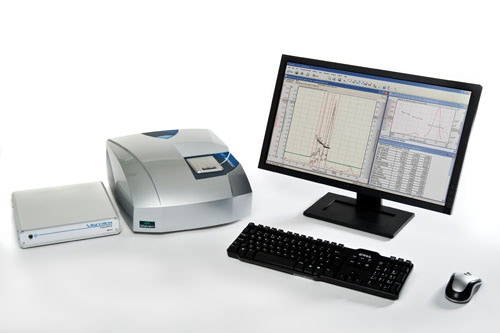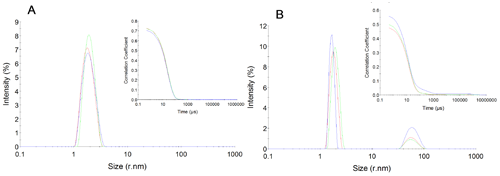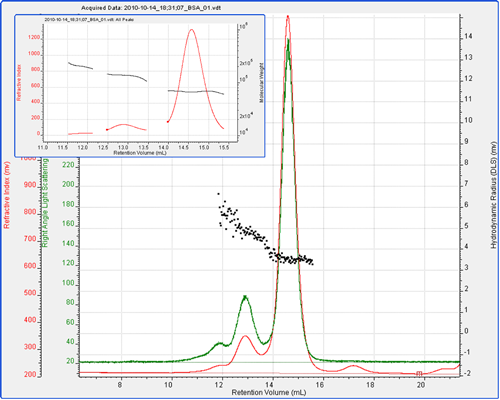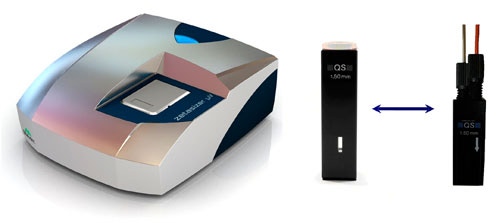The Zetasizer µV is a 90° light scattering instrument capable of both dynamic light scattering (DLS) and static light scattering (SLS) measurements. It has a 50 mW variable power laser, continuous attenuator and avalanche photodiode and is dedicated to measurements of proteins. The system’s 90° measurement angle means small measurement volumes can be measured. In stand-alone cuvettes, the minimum sample volume is 2 µl while the flow cell is just 8 µl.

|
The OmniFACE is an analogue/digital interface board designed to enable the connection of the Zetasizer µV to a size-exclusion chromatography system. OmniSEC is a full chromatography software suite for collection and analysis of SEC data.
The OmniFACE connects via RS-232 to the PC. It can accept analogue signals from up to 2 concentration detectors which are generally expected to be either refractive index (RI) or ultraviolet (UV). The OmniFACE can also accept a contact-closure type trigger signal from an autosampler to enable integration into an automated system. The combination of the Zetasizer µV, OmniFACE and OmniSEC create a complete modular detector solution for integration into an SEC system. The universality of the connections means the Zetasizer µV can be connected to almost any third-party chromatography system.
The Zetasizer µV is capable of DLS and SLS measurements from samples in cuvettes. As a batch DLS system, the Zetasizer µV has excellent sensitivity and produces measurements of the highest quality. The design of the Zetasizer µV makes its ideal size range at the lower end, from 0.3 to 500 nm radius meaning it is ideally suited to the measurement of proteins.
The 90° optical setup, high variable-power laser with attenuator and dedicated software make collecting data and performing DLS measurements simple, even for users who are not experienced in the technique.
Typical protein applications for DLS are the measurement of protein stability. As a quick, non-invasive measurement, DLS is well suited to formulation studies and the sensitivity of light scattering to aggregated material means that it is very sensitive to the earliest stages of protein aggregation. Figure 2 shows a typical example of a protein application. Figure 2A shows a three overlaid measurements of Lysozyme with the associated correlation functions inset. Figure 2B shows the sample as it has begun to aggregate, also with the associated correlation functions inset.

|
As a SEC detector, the Zetasizer µV measures the intensity of light scattered by the sample as it elutes. It can be used in conjunction with a concentration detector, either RI or UV, to measure the molecular weight of the sample using the technique of static light scattering (SLS). The measurement of light scattering intensity is performed at a single angle. This means that measurements of molecular weight by SLS using the Zetasizer µV is appropriate only for small molecules such as proteins.
At the same time, the Zetasizer µV can continuously generate correlation functions. This allows the size of the eluting sample to be measured using DLS.
By combining SLS and DLS, as a modular SEC detector, the Zetasizer µV can simultaneously measure both the size and the molecular weight of the eluting sample. Figure 3 shows a measurement of the protein bovine serum albumin (BSA). The sample has been separated into three peaks - visible on the RI and the light scattering detectors. Overlaid, the hydrodynamic radius, measured by DLS is plotted across the three peaks.

|
In the inset chromatogram, the RI trace is shown in red, with molecular weight in black.
The addition of a second concentration detector enables further, compositional experiments to be made. This allows the concentration of two components in a mixed sample to be individually measured, providing the response factors of the two detectors to each component are known.
Typical applications in this area would be membrane proteins associated with detergents or measuring the level of protein PEGylation.
The Zetasizer µV is a combined DLS and SLS capable instrument. It can be used as a stand-alone detector for analyzing samples in a cuvette or as a fully-featured modular chromatography detector. For protein applications, this makes the Zetasizer µV an ideal tool. Common protein applications in stand-alone batch mode include the study of molecular size and formulation stability. Common applications in SEC systems include the measurement of molecular weight and the determination of oligomeric state as well as the detection and quantification of any aggregated material in the sample.
The Zetasizer µV can be rapidly switched between cuvette and SEC modes. This is done simply by replacing the measurement cuvette with a flow cell. (figure 4).

|